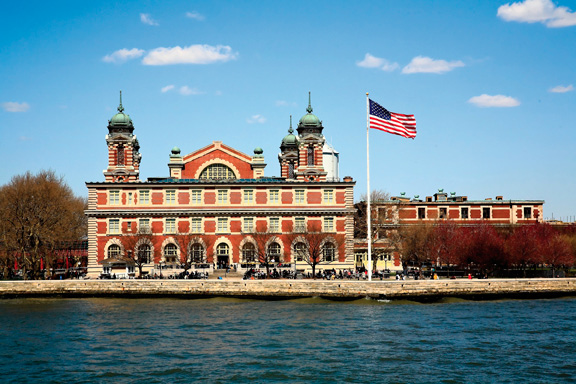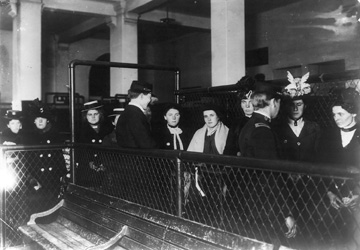Gateway to America

As the first- and second-class passengers disembarked at a Manhattan pier, the steerage passengers remained aboard the steamship. They had to wait for the U.S. Immigration Service ferry to take them across New York Harbor to Ellis Island. These anxious passengers were dressed in their best clothes to impress the officials and prove that they were worthy of becoming Americans.
In the late 1800s, huge numbers of immigrants wanted to come to the United States. The federal government established immigration processing stations to monitor the flow of these people. Immigrants underwent a series of medical and mental checkups before being permitted to enter the country. Located between Jersey City, New Jersey, and lower Manhattan in New York City, Ellis Island became the most famous of these stations. It first opened its doors as a federal immigration station on January 1, 1892.
Once on the island, the immigrants stood beneath a canopy that extended from the dock’s edge to the gigantic red and white main building. Immigrants entered into the first floor Baggage Room, where they deposited their belongings. Then, they climbed the stairs to the Registry Room while inspectors watched for any obvious medical issues. Those who had noticeable problems would undergo more thorough exams.

As the passengers proceeded through a maze of pipe railings on the second-floor balcony, doctors checked the general health of each one. Once their physical health was clear, the immigrants were moved to the Registry Room, also known as the Great Hall. There, people stood in long lines, waiting for interpreters to translate the inspectors’ questions. Officials wanted to make sure new immigrants had a place to go and a job waiting for them. When satisfied with the answers, the officials waved the immigrants through to board the ferry back to Manhattan—and the start of a new life.
Ellis Island went through some changes over the years. Originally encompassing three acres, the island gradually was enlarged to 27 ½ acres by adding landfill. The complex eventually included three connected islands with hospitals, dormitories for those who remained on the island overnight, a bakery, and a rooftop playground for children.
During World War I (1914–1918), immigration decreased, and the island was used to house prisoners of war. As immigration laws became stricter in the 1920s, fewer people passed through Ellis Island, and it became a holding center for those being deported. During World War II (1939–1945), the U.S. Coast Guard used it as a training center. The center closed in 1954, but President Lyndon B. Johnson made it part of the Statue of Liberty National Monument in 1965. It opened for limited tours in 1976 but closed again in 1984 for repairs.
In 1982, The Statue of Liberty–Ellis Island Foundation was established to raise funds for the restoration and preservation of both the Statue of Liberty and Ellis Island. On July 4, 1986, a centennial celebration was held in honor of the renovated Statue of Liberty. On September 10, 1990, Ellis Island’s main building, restored to the way it looked between 1918 and 1924, reopened as the Ellis Island Immigration Museum. More than 30 other buildings remain unrestored.
Today, this popular national park site pays tribute to the approximately 12 million immigrants who took risks and left their homelands to find a better life in the United States. About 40 percent of Americans can trace their roots to an ancestor who passed through Ellis Island. For them, a chance to experience what a relative went through is just a ferry ride away.